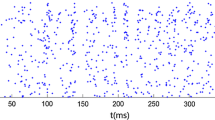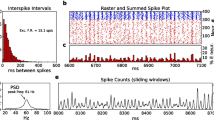Abstract
Gamma oscillations are a prominent phenomenon related to a number of brain functions. Data show that individual pyramidal neurons can fire at rate below gamma with the population showing clear gamma oscillations and synchrony. In one kind of idealized model of such weak gamma, pyramidal neurons fire in clusters. Here we provide a theory for clustered gamma PING rhythms with strong inhibition and weaker excitation. Our simulations of biophysical models show that the adaptation of pyramidal neurons coupled with their low firing rate leads to cluster formation. A partially analytic study of a canonical model shows that the phase response curves with a near zero flat region, caused by the presence of the slow adaptive current, are the key to the formation of clusters. Furthermore we examine shunting inhibition and show that clusters become robust and generic















Similar content being viewed by others
References
Bartos, M., Vida, I., Jonas, P. (2007). Synaptic mechanisms of synchronized gamma oscillations in inhibitory interneuron networks. Nature Reviews Neuroscience, 8, 45–56.
Börgers, C., & Kopell, N. (2003). Synchronization in networks of excitatory and inhibitory neurons with sparse, random connectivity. Neural Computation, 15 (3), 509–539.
Börgers, C., & Kopell, N. (2005). Effects of noisy drive on rhythms in networks of excitatory and inhibitory neurons. Neural Computation, 17 (3), 557–608.
Börgers, C., Epstein, S., Kopell, N. (2005). Background gamma rhythmicity and attention in cortical local circuits: A computational study. Proceedings of the National Academy of Science USA, 102 (19), 7002–7007.
Cunningham, M. O., Whittington, M. A., Bibbig, A., Roopun, A., LeBeau, F. E. N., Vogt, A., Monyer, H., Buhl, E. H., Traub, R. (2004). A role for fast rhythmic bursting neurons in cortical gamma oscillations in vitro. Proceedings of the Natural Academy of Sciences USA, 101, 7152–7157.
Engel, A., Fries, P., Singer, W. (2001). Dynamic predictions: oscillations and synchrony in top-down processing. Nature Reviews Neuroscience, 2, 704–716.
Ermentrout, G. B., Pascal, M., Gutkin, B. S. (2001). The Effects of Spike Frequency Adaptation and Negative Feedback on the Synchronization of Neural Oscillators. Neural Computation, 13, 1285–1310.
Ermentrout, G. B., & Kopell, N. (1991). Journal of Mathematical Biology, 29, 195–217.
Ermentrout, G. B., & Kopell, N. (1990). Oscillator death in systems of coupled neural oscillators. SIAM Journal on Applied Mathematics, 50 (1), 125–146.
Fenichel, N. (1979). Geometric singular perturbation theory for ordinary differential equations. Journal Differential Equations, 31, 53–98.
Fries, P., Reynolds, J., Rorie, A., Desimone, R. (2001). Modulation of oscillatory neuronal synchronization by selective visual attention. Science, 291, 1560–1563.
Golomb, D., & Rinzel, J. (1994). Clustering in globally coupled inhibitory neurons. Physica D, 72, 259–282.
Gray, C. M. (1999). The temporal correlation hypothesis of visual feature integration: still alive and well. Neuron, 24, 31–47.
Jeong, H. Y., & Gutkin, B. S. (2007). Synchrony of neuronal oscillations controlled by GABAergic reversal potentials. Neural Computation, 19 (3), 706–729.
Gutkin, B. S., Ermentrout, G. B., Reyes, A. (2005). Phase-response curves give the responses of neurons to transient inputs. Journal of Neurophysiology, 94, 1623–1635.
Jia, X., Smith, M. A., Kohn, A. (2011). Stimulus selectivity and spatial coherence of gamma components of the local field potential. Journal of Neuroscience, 31 (25), 9390–9403.
Kilpatrick, Z., & Ermentrout, B. E. (2011). Sparse gamma rhythms arising through clustering in adapting neuronal networks. PLOS Computational Biology, to appear.
Krupa, M., & Szmolyan, P. (2001). Extending singular perturbation theory to nonhyperbolic points – fold and canard points in two dimensions. SIAM Journal on Mathematical Analysis, 33, 286–314.
von Stein, A., & Sarnthein, J. (2000). Different frequencies for different scales of cortical integration: from local gamma to long range alpha/theta synchronization. International Journal of Psychophysiology, 38 (3), 301–13.
Stiefel, K. M., Gutkin, B. S., Sejnowski, T. E. (2009). The effects of cholinergic neuromodulation on neuronal phase-response curves of modeled cortical neurons. Journal Computational Neuroscience, 29, 289–301.
Tallon-Baudry, C., Bertrand, O., Peronnet, F., Pernier, J. (1998). Induced gamma- band activity during the delay of a visual short-term memory task in humans. Journal of Neuroscience, 18, 4244–4254.
Vida, I., Bartos, M., Jonas, P. (2006). Shunting inhibition improves robustness of gamma oscillations in hippocampal interneuron networks by homogenizing firing rates. Neuron, 49, 107– 117.
Wang, X. J. (2010). Neurophysiological and computational principles of cortical rhythms in cognition. Physiology Review, 90, 1195–1268.
Whittington, M. A., Stanford, I. M., Colling, S. B., Jefferys, J. R. G., Traub, R. D. (1997). Spatiotemporal patterns of gamma frequency oscillations tetanically induced in the rat hippocampal slice . Journal Physiology, 502, 591–607.
Acknowledgments
The research of MK was supported in part by a grant from the city of Paris (Bourse de la ville de Paris) and by CLS NWO grant to Stan Gielen. The research of BG was supported by the CNRS, INSERM, ANR, ENP, by Ville de Paris and by the Basic Research Program of the National Research University Higher School of Economics, Moscow, Russia. The research of SG was supported in part by the CLS program of NWO.
Conflict of interest
The authors declare that they have no conflict of interest.
Author information
Authors and Affiliations
Corresponding author
Additional information
Action Editor: N. Kopell
Appendix: Review of the result of Krupa and Szmolyan (2001) and the estimate of T e s c
Appendix: Review of the result of Krupa and Szmolyan (2001) and the estimate of T e s c
Consider
Note that system (30) has the same form as system (2.5) in Krupa and Szmolyan (2001). The following estimate is a consequence of Theorem 2.1 and Remark 2.11 in Krupa and Szmolyan (2001). Let Ω0 be the smallest positive zero of the function
where J −1/3 (resp. J 1/3) are Bessel functions of the first kind.
Proposition 3
Let y 0 ≥0 and x 0 <0 satisfy f(x 0 ,y 0 )=0. Also fix δ>0. Consider a family of solutions of Eq. ( 30 ) with initial conditions x(0)=x 0 +O(ε) and y(0)=y 0 . Let (δ,h(ε)) be the intersection point of this trajectory with the line x=δ. Then, for sufficiently small δ,
Now let T be the time needed for a trajectory with initial condition x 0<0, y 0=0. It follows from Eq. (31) and the form of Eq. (30) that ε T≈−Ω0 ε 2/3. It follows that
By scaling the variables and time (30) can be brought to the form Eq. (15) and estimate Eq. (16) can be obtained.
Rights and permissions
About this article
Cite this article
Krupa, M., Gielen, S. & Gutkin, B. Adaptation and shunting inhibition leads to pyramidal/interneuron gamma with sparse firing of pyramidal cells. J Comput Neurosci 37, 357–376 (2014). https://doi.org/10.1007/s10827-014-0508-6
Received:
Revised:
Accepted:
Published:
Issue Date:
DOI: https://doi.org/10.1007/s10827-014-0508-6




